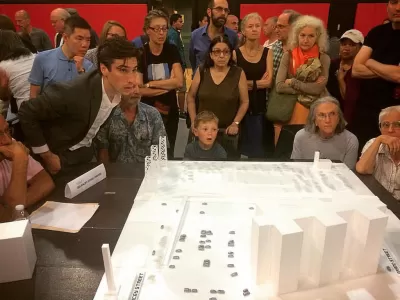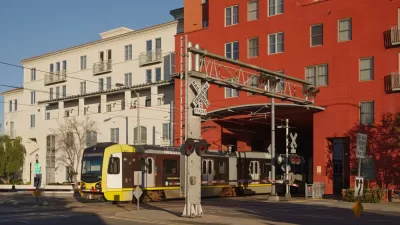Some argue that neighborhoods will be willing to accept new housing as long as it is high quality; this argument overlooks a wide variety of other objections to new housing.

One argument I’ve heard in new urbanist circles runs as follows: "Neighborhood activists oppose new housing only because they have been subjected to so much ugliness in recent decades. If we just built less ugly stuff and made builders provide more parks and other amenities, neighborhoods would be willing to support rezonings for as much housing as we need." If this argument were correct, there would be no need for institutional reform to discourage "Not In My Back Yard" (NIMBY) opposition to housing: instead, we would just need prettier buildings and more parks.
This argument would make sense if design-related objections were the only objections to new housing. But in fact, inadequate design is just one of only many anti-housing arguments. As Benjamin Ross wrote in the book Dead End, there is a nearly infinite variety of anti-development arguments: "There's either too much parking or too little. If houses are proposed, offices are what the neighborhood needs; if offices, houses would be better. Property values will go down; we will be priced out of our homes."
It could be argued that these arguments are all fraudulent, and that NIMBYs are really just afraid of ugly buildings. But to make this argument, you have to believe that ever since the birth of zoning in the 1920s, thousands of activists, city councils, and mayors all over North America have been just pretending to be concerned about property values or parking or racial transition or any other objection they raise, but are in fact concerned (either consciously or subconsciously) about design. The only way to prove beyond a reasonable doubt that this claim is false is to probe the subconscious attitudes of thousands of people—a project that seems to me to be impossible. But the claim nevertheless seems highly implausible to me. In my experience, people either say what they mean, or at least say something vaguely resembling what they mean.
Let us suppose that planners and builders act as if this argument was true, and negotiate with community groups to provide the most attractive housing possible. Would this be a good thing? Yes, in a world of unlimited resources.
On the other hand, features that increase housing quality often cost money, which in turn might make housing more expensive. For example, if every subdivision with over 50 houses had a park attached, that might cost more money than the same subdivision without a park attached. Or builders might have to build fewer units in order to accommodate the park, thus reducing regional housing supply and making housing more expensive than it would otherwise be. Furthermore, the amount of time spent negotiating with the community to make a development perfect might also be costly, since time is money. For example, if landowner X hires architectural firm Y to design a subdivision or a condominium, X has to spend more money if Y spends two weeks getting community input than she would if Y spends two days on doing so.
Moreover, a world of beautiful-but-expensive housing might actually lead to more NIMBYism. How so? Because in cities with expensive housing, NIMBYs argue that new housing is too expensive and thus spurs gentrification and displacement. So if a city starts requiring higher-quality housing, it might wind up raising housing costs and feeding the NIMBY beast in the long run.
Appeasing neighbors with better design might work for an individual developer. And for a city, public benefits such as popular design and public amenities might reduce NIMBY resistance to new housing- especially if the public benefits are tied to density bonuses.* So this strategy might be better than building nothing—but if your goal is to hold down housing prices, beauty is no substitute for deregulation.
*In this context, I notice that Vancouver, a world leader in this policy, also has extremely expensive housing. So as much as I admire Vancouver's achievements in other respects, I don't consider Vancouver to be an affordability role model.

Planetizen Federal Action Tracker
A weekly monitor of how Trump’s orders and actions are impacting planners and planning in America.

Chicago’s Ghost Rails
Just beneath the surface of the modern city lie the remnants of its expansive early 20th-century streetcar system.

San Antonio and Austin are Fusing Into one Massive Megaregion
The region spanning the two central Texas cities is growing fast, posing challenges for local infrastructure and water supplies.

Since Zion's Shuttles Went Electric “The Smog is Gone”
Visitors to Zion National Park can enjoy the canyon via the nation’s first fully electric park shuttle system.

Trump Distributing DOT Safety Funds at 1/10 Rate of Biden
Funds for Safe Streets and other transportation safety and equity programs are being held up by administrative reviews and conflicts with the Trump administration’s priorities.

German Cities Subsidize Taxis for Women Amid Wave of Violence
Free or low-cost taxi rides can help women navigate cities more safely, but critics say the programs don't address the root causes of violence against women.
Urban Design for Planners 1: Software Tools
This six-course series explores essential urban design concepts using open source software and equips planners with the tools they need to participate fully in the urban design process.
Planning for Universal Design
Learn the tools for implementing Universal Design in planning regulations.
planning NEXT
Appalachian Highlands Housing Partners
Mpact (founded as Rail~Volution)
City of Camden Redevelopment Agency
City of Astoria
City of Portland
City of Laramie






























